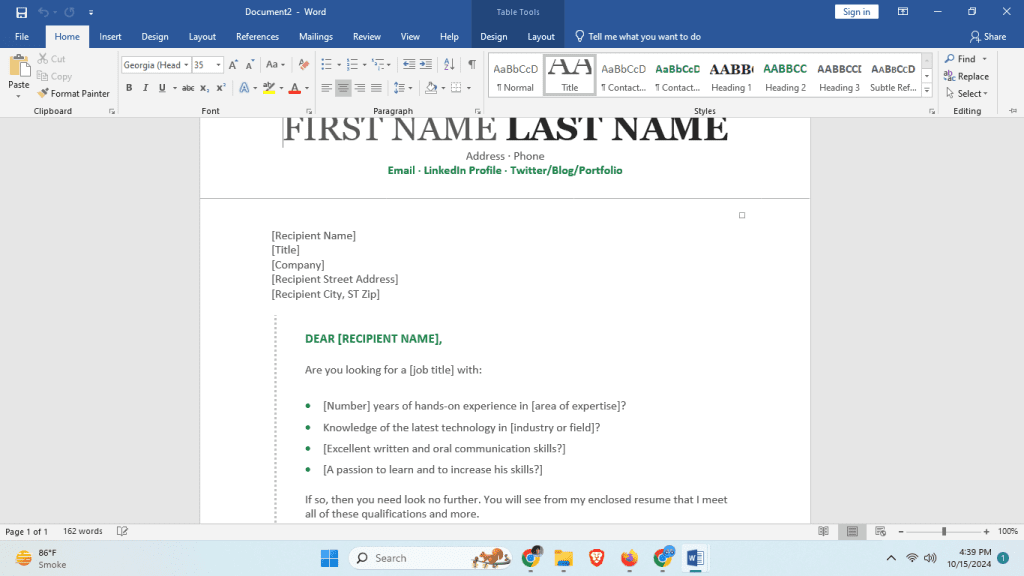Last Updated: January 24, 2025
Do you ever get tired of spending a lot of time making documents in Microsoft Word? What if I told you there’s an easier way to save time? Learning how to modify existing templates in Microsoft Word can help a lot. Whether you’re working on a report, resume, or invitation, making a few changes to a ready-made template can save time and make your work look great. In this blog, I’ll show you step-by-step how to modify templates in Word easily to be more productive.
Table Of Contents
- 1 Introduction: Why Change Existing Templates in Microsoft Word?
- 2 Benefits of Modifying Existing Templates in Microsoft Word
- 3 How to Modify Existing Templates in Microsoft Word
- 4 FAQs About Modifying Existing Templates in Microsoft Word
- 5 Tips for Modifying Existing Templates in Microsoft Word Effectively
- 6 Conclusion: Start Changing Templates Today!
Introduction: Why Change Existing Templates in Microsoft Word?
Microsoft Word templates are really helpful for anyone who works with documents often. These pre-made templates save time while keeping a professional look. But sometimes, the default templates need a bit of adjusting to fit your needs. To learn more about the best Microsoft Word templates for resumes, check out this guide. Modifying an existing template lets you add your personal touch and branding, making it more useful for your project. In this guide, you’ll learn how to modify existing templates in Word and see how it can make your work easier and faster.
Benefits of Modifying Existing Templates in Microsoft Word
1. Save Time and Work Faster
The biggest reason to change templates is to save time. Imagine having a well-designed template that only needs small changes to fit your needs. You can avoid starting from scratch, which saves hours of work. Studies show that using templates can cut document creation time by up to 60%. You can explore more about Microsoft Word’s built-in templates here.
2. Keep a Consistent Look
If you care about how your brand looks, modifying existing templates is key. Adding your logo, using your brand colors, and adding your company fonts make sure all your documents, like presentations, reports, and emails, look the same. This helps keep a professional and uniform look for all your work.
3. Make High-Quality Documents
Modifying existing templates helps you make high-quality documents without much effort. Microsoft Word templates already have good formatting, tables, styles, and sections that make them easy to read. By changing them, you can make sure they fit your needs while still looking professional.
How to Modify Existing Templates in Microsoft Word

1. Open the Template to Edit
To change an existing template in Microsoft Word, first, open the template. Here’s how:
- Open Microsoft Word.
- Click on “File” > “Open”.
- Find the template you want to edit. Microsoft Word has many built-in templates, or you may have downloaded one. If you want to create your own, here is a helpful guide on creating custom templates in Microsoft Word.
- Click “Open” to load the template.
2. Adjust Styles and Formatting
Once your template is open, start changing the styles and formatting. You can change the font type, size, and color, and adjust headings to match your style. Here’s how:
- Go to the “Home” tab.
- Click on the styles (e.g., Heading 1, Heading 2) to change the text.
- Use the “Format Painter” to apply these changes to similar sections.
3. Add Branding Elements
To make the template more personal, add elements like logos, headers, and footers. To add a logo:
- Go to “Insert” > “Pictures” > Select the logo file from your computer.
- Place it in the header or footer to give the document a consistent branded look.
Adding headers and footers makes sure your document looks uniform. You can also add a watermark if needed, like “Draft” or “Confidential”.
4. Edit Content Placeholders
Many templates have placeholders with generic text like “Insert Text Here”. Change these placeholders to add your real content. Add your information, like contact details, headings, or personal notes.
5. Save the Updated Template
Once you’ve made all your changes, make sure to save the updated version. To save it as a template:
- Click “File” > “Save As”.
- Under “Save as type”, choose “Word Template (*.dotx)”.
- Give it a unique name and click “Save”.
Saving it as a template means you can use it again whenever you need it. If you are interested in more tips on downloading and using templates, visit how to download templates from Office.com.
FAQs About Modifying Existing Templates in Microsoft Word
1. Why Change an Existing Template Instead of Making One from Scratch?
Modifying an existing template is much faster than making one from scratch. Templates give you a starting point, and you can just adjust what you need. This saves hours of work and makes you more productive. Learn more about the benefits of using Word templates at Microsoft Word Templates Guide.
Yes! You can share your updated template with team members. Just send them the template file, and they can use it like any other Word document. This helps keep documents consistent across your team. For more details, check out how to share a Word document.
3. Are There Limits to Changing Templates in Microsoft Word?
While changing templates is usually easy, there are some limits. If a template has complex elements (like macros or advanced graphics), it may be harder to change. But most basic edits, like text and style changes, are easy to do. You can find more information about the limitations of editing templates at Microsoft Word Help & Learning.
Tips for Modifying Existing Templates in Microsoft Word Effectively
1. Use Shortcut Keys
Use shortcut keys to make changes faster. For example:
- Ctrl + B to bold text.
- Ctrl + C and Ctrl + V to copy and paste.
- Alt + Ctrl + Shift + S to open the styles panel.
2. Keep a Backup of the Original Template
Always keep a backup of the original template. This is helpful if you want to go back to the original design or create a different version later. You can also save different versions for different purposes.
3. Keep Formatting Consistent
When changing the template, make sure you keep the formatting consistent. Use the same fonts, colors, and headings throughout the document. Consistent formatting makes your document look more professional.
Conclusion: Start Changing Templates Today!
modifying existing templates in Microsoft Word can make your work much faster and easier. Instead of starting from scratch, use a template and modify it to fit your needs. Whether you want to make a branded report, a personal letter, or a well-designed resume, changing templates will save you time and improve the quality of your work.
Master these skills to keep your documents looking professional and focus on what matters—creating great content. Start changing your templates today and watch your productivity grow!




